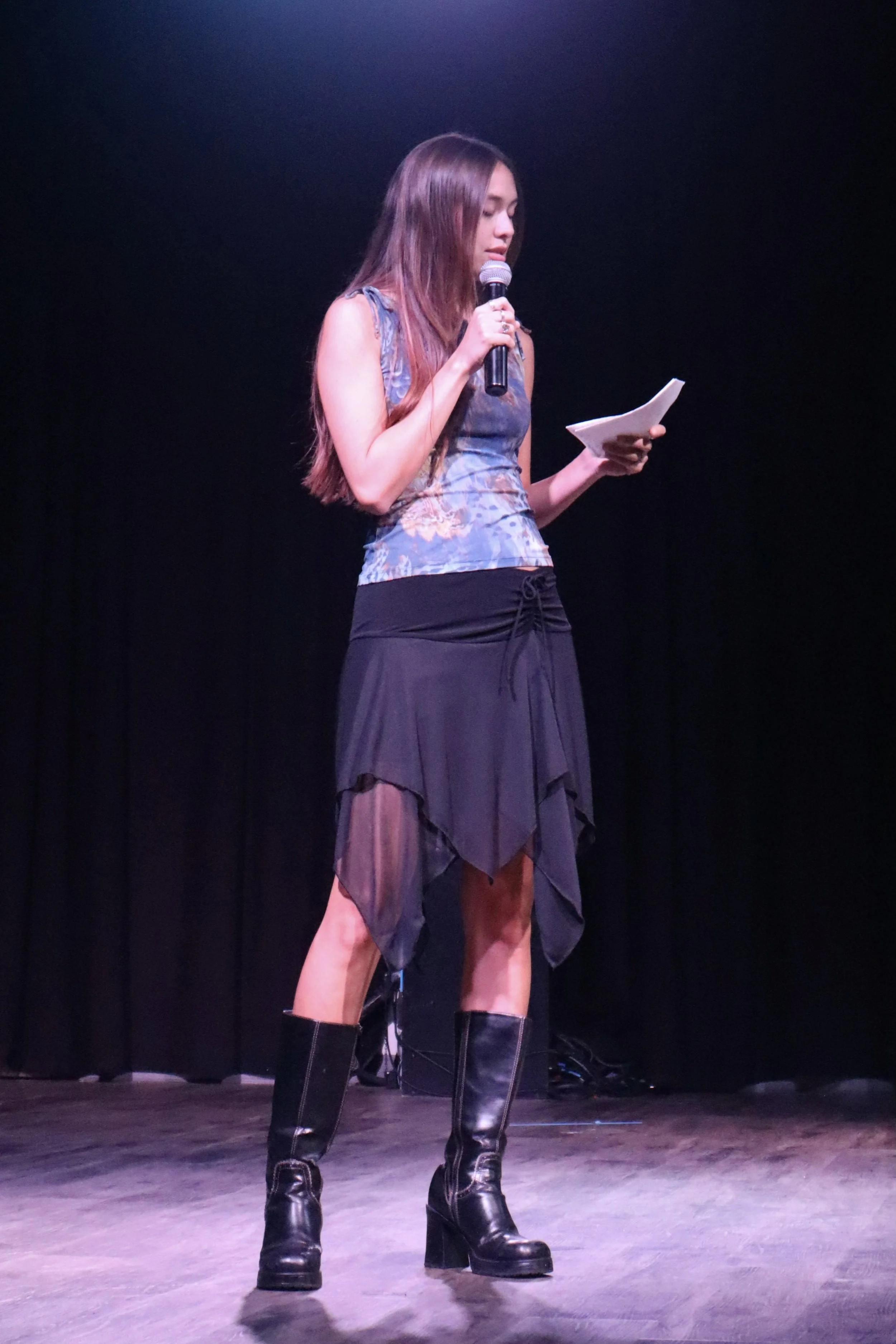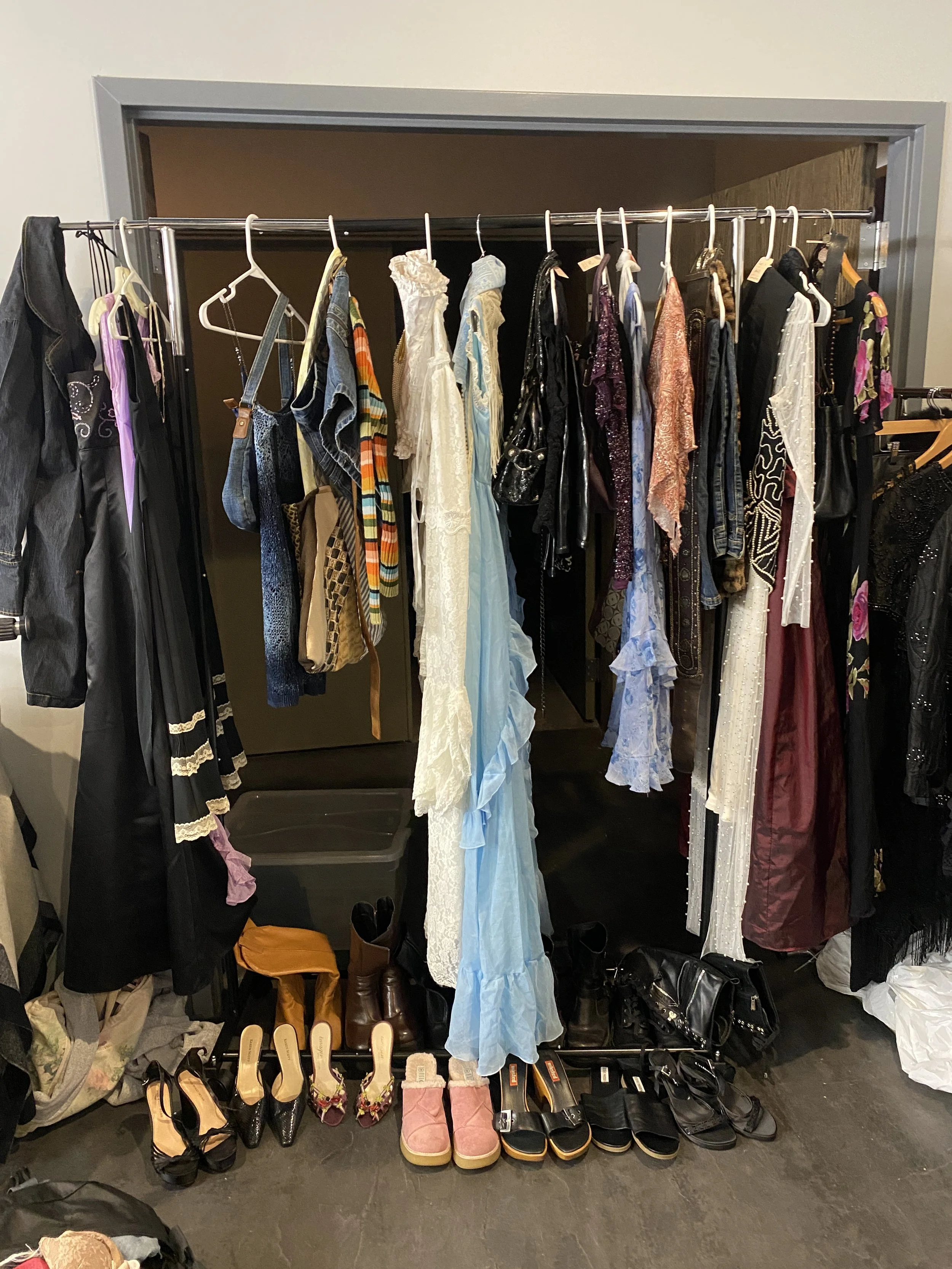Green Fashion, Great Cause: Styling My First Show and Speaking on Sustainability
Here’s me on stage, doing the one thing so many of us dread: public speaking.
My biggest concern here wasn’t publicly presenting my love for blending fashion and environmentalism—it was trying to avoid a coughing fit (I’d discover I was dealing with a respiratory infection at this time).
But let’s go back a few weeks before this moment.
I was about to scroll through the endless content of Instagram again when I noticed a new DM.
A connection from high school messaged me. She was hosting a fashion show for charity and needed a last-minute designer to replace one that dropped out.
I told her I was interested immediately. I didn’t let myself think too hard about it because if I did, I could worry and potentially pass up the opportunity before I could figure out the details.
I’ve been trying to say yes to more things outside my comfort zone and I’ve loved curating clothes for years, so this opportunity spoke to me. At this time of writing, I’ve spent nearly a decade selling clothes online and I was starting to become more serious about curating and selling vintage fashion.
I knew I needed an experience like this to get me out of my comfort zone, so I made myself say, “Absolutely, I’ll do this.”
With only a few weeks before the charity event, I got to work sourcing unique vintage clothing from my go-to location. More on that later.
But as the show date approached, I found myself low-energy and even lower on inspiration. I caught my first cold of the season, which was beginning to turn into a respiratory infection that would keep me coughing and sleepless for a month.
In the meantime, I was working off a spreadsheet of the model’s sizes to find styles to their exact measurements, and the options of outfits began to pile up in my small living room.
I finalized the collection—and even came up with some last-minute styles—the very morning of the event as I was packing my suitcases.
The fashion show was the fourth annual Show for Hope and proceeds were to be donated to the American Foundation for Suicide Prevention.
I reserved an event table for my family and friends to join me in support (I think the promise of an open bar and food encouraged them to come too). When I arrived, I took a moment to watch the models practice their walks before I arranged each outfit with their model.
This was one of the most memorable, enjoyable parts of my day.
One-by-one a girl would introduce themselves with their name and I’d pair them with a prepared style in their size. The best part of this was their reactions as they took their hanger from me.
“I love this, thank you!” I was told.
After try-ons, I added accessories and made small adjustments. The models looked at each other after getting dressed, comparing the ranges of looks I had put together.
“I seriously love everything you have,” one told me.
There were three other designers at the show. I was the fourth, and last, on the list. I’d be closing out the event.
I was okay with that. At least recency bias would mean everyone might remember mine best, I thought.
The other designers had unique handmade bags resembling eyes and lips, elevated consignment fashions, and boutique styles for the fall/winter season. My friends and family pointed out their favorite looks of each designer’s show as the moment built up for my own.
Backstage, I wrote out my speech on some sketchbook paper before looking over each model for any final adjustments.
“Are you ready?” one model asked me excitedly as we waited backstage. She was referring to the introductory speech I had volunteered to prepare and present myself.
Honestly, I wasn’t nervous about giving the speech, probably because I felt so excited and comfortable about the subject I was about to talk about. It was something I actively tried to shut up about with friends, and now I was being asked to introduce it to a crowd.
As I began addressing the audience, I found myself happily in the moment. I forgot any anxieties I had and got into a flow with my words, letting my passion for the topic take over instead of reading straight from my script.
I explained that the goal of my collection was to promote circular fashion. Globally, around 87% of discarded textiles ended up in landfill, of which more than 90% are reusable and recyclable. Fashion trends have become more fleeting—some now lasting weeks instead of seasons—and cheaply made fast fashion styles may only survive a few wears.
The price for cheap clothing costs us: fast fashion can only exist with poor labor practices and microplastic shedding fabrics made of oil, and the end life of these items is ultimately a landfill. Donation centers often have more donations than they can hold, and if you’ve thrifted recently, you might’ve seen how many clothes on those racks are from fast fashion brands.
Additionally, our country has a problem with overconsumption and the common practice of single-use items. This issue is so pervasive that some even consider outfits single use for an Instagram photo or one wear out before being discarded. Trends of ‘normalizing being an outfit repeater’ have arisen, as if rewearing clothing isn’t normal anymore.
I had frequented regular thrift stores for years, but I didn’t truly see the effects of our overconsumption and fashion waste until I found another place.
Just a few stops before they end up in a landfill, thousands of garments make their way to stores such as the Goodwill Outlets. Here, unsorted wares are dumped into giant bins and cycled throughout the day, often by the hour. Textiles, books, shoes, and wares (i.e. anything else you can think of) are priced by the pound for those willing to sort through the bundles.
This is where I sourced all the clothing, accessories, shoes, and materials for my collection.
I wanted this show to be a surprising look for the crowd of what ends up discarded and destined for the trash.
Photo credit: Pat + Cassie.
After concluding my speech and thanking the crowd, I went to view my show from backstage. I peaked from the curtains as the models and my styles made their debut. Some looks I designed to be more casual for even non-fashion lovers, some were handmade, and some were bold.
I remember the moment I heard applause. Suddenly, I was following the train of models out for a final walk.
As I write and reflect about this event, I’ve always felt grateful for every opportunity that was outside of my comfort zone, but I said yes to anyways.
Before this, fashion—particularly my interest in circular fashion—was something I shared with close friends or virtually through my online selling.
Meeting others within my community to explore fashion was refreshing, and even my family and friends showed greater interest in circular fashion after my show.
Thank you to the hosts of Show for Hope, Jay Marie Salon, for this wonderful charity event. Thank you to the photographers Pat & Cassie for the professional images below. And of course, thank you to all the models who modeled my collection and that I got to share my love of clothes with.
Let’s love fashion responsibly.


















Slideshow photo credits: Pat + Cassie.Here’s a recommended article for further reading on this topic: We’re in the Golden Age of Garbage Clothing | The Walrus.





